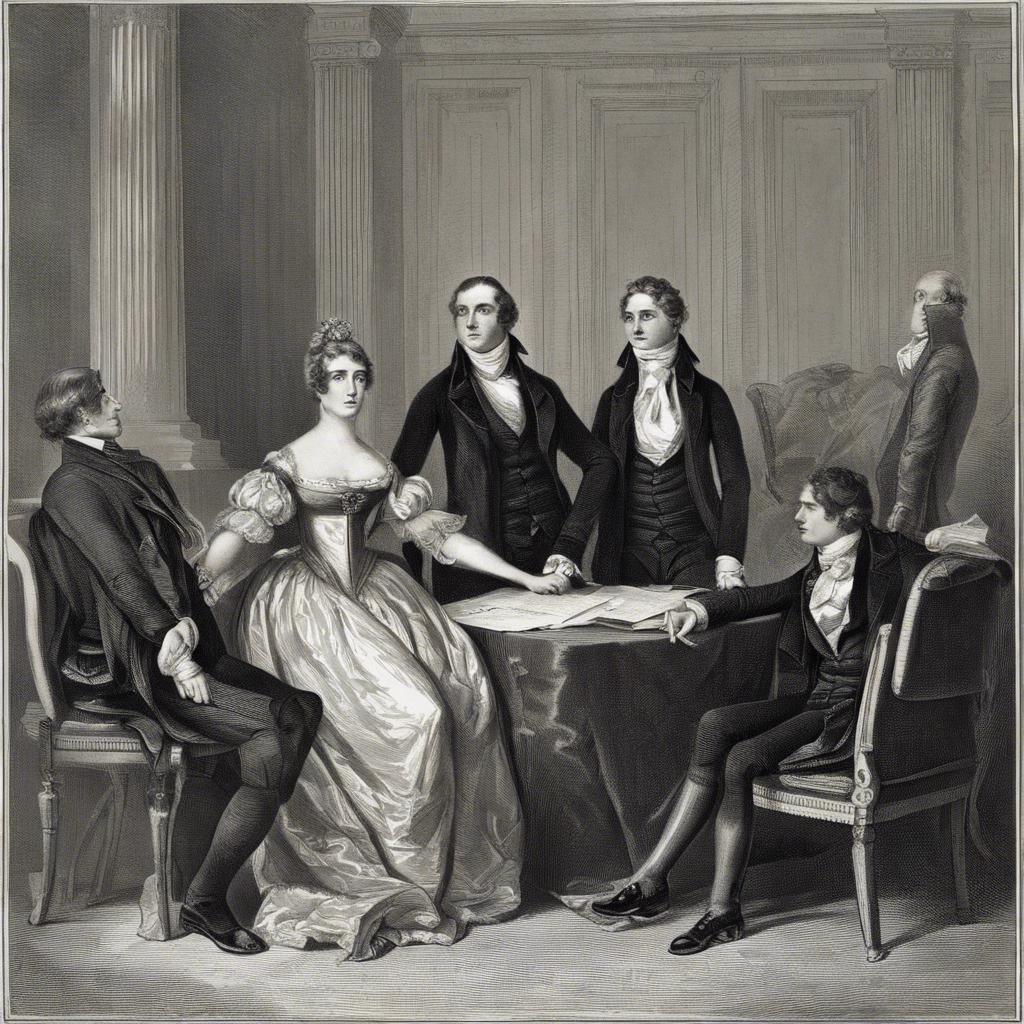During the Regency era in England, the intricacies of inheritance laws played a significant role in shaping the lives and legacies of the aristocracy. In this article, we will delve into the complexities of regency era inheritance laws, exploring how these legal frameworks influenced the distribution of wealth, power, and privilege among the upper class during this pivotal period in British history. Join us as we journey back in time to uncover the legalities and implications of inheritance in the Regency era.
Step Into the World of Cheryl Bolen
Dive into the enchanting stories of love, intrigue, and elegance set in the Regency Era. Cheryl Bolen's novels offer timeless romance and captivating tales that will leave you wanting more.
Explore Cheryl Bolen's Books Now
Overview of Regency Era Inheritance Laws
The Regency Era in England, spanning from 1811 to 1820, was a period marked by significant changes in inheritance laws. During this time, inheritance laws played a crucial role in determining the distribution of wealth and property among the aristocracy and the common people.
**Key aspects of Regency Era inheritance laws included:**
- Primogeniture: The eldest son inherited the bulk of the family estate, leaving younger siblings with significantly less.
- Entailment: Estates were often entailed, meaning they could only be passed on to direct descendants, further limiting inheritance options.
- Dower rights: Widows were entitled to a portion of their deceased husband’s estate, providing some financial security after his passing.
**Inheritance laws during the Regency Era had a profound impact on society:**
- They reinforced the social hierarchy by concentrating wealth and power in the hands of the aristocracy.
- They limited opportunities for upward mobility and financial independence among the lower classes.
- They fuelled disputes and tensions within families over inheritance rights, leading to legal battles and strained relationships.
- Exploring the complexities of inheritance laws during the Regency era
The complexity of inheritance laws during the Regency era was a topic of great interest and debate among the upper class of society. Inheritance laws dictated who would inherit property, titles, and wealth upon the passing of an individual. These laws were influenced by societal norms, gender roles, and familial traditions, making them a fascinating and intricate aspect of Regency society.
One of the key factors that made inheritance laws during the Regency era so complex was the concept of primogeniture. Primogeniture dictated that the eldest son would inherit the bulk of his father’s estate, including titles and land. This system often left younger sons and daughters with little to no inheritance, leading to issues of financial stability and social standing within the family.
Another complicating factor in Regency inheritance laws was the lack of legal rights for women. In most cases, women were not able to inherit property or titles directly, unless there were no male heirs in the family. This lack of legal rights for women often led to disputes and challenges within families, as daughters and widows sought to secure their financial futures in a society that heavily favored male inheritance.
– Understanding the impact of primogeniture and entailment on inheritances
The Regency era witnessed a significant impact of primogeniture and entailment on inheritances, shaping the distribution of wealth and property within noble families. Primogeniture, the practice of passing down all inheritance to the firstborn son, ensured the consolidation of family estates and titles. Younger siblings, particularly daughters, were often left with limited or no inheritance, perpetuating inequalities within society.
Entailment, on the other hand, restricted the ability of landowners to sell or divide their estates, keeping the properties intact and within the family line. This legal restriction aimed to maintain the wealth and status of the aristocracy, but it also limited the financial independence and opportunities for future generations. The combination of primogeniture and entailment created a complex system of inheritance that favored the eldest male heir.
During this era, inheritances were not only about passing down material possessions but also about securing social standing and influence. The laws of primogeniture and entailment played a crucial role in maintaining the hierarchy of power and privilege within the aristocratic society of the time, shaping the lives and destinies of individuals based on their birth order and gender.
– Important considerations for individuals navigating Regency era inheritance laws
In the Regency era, inheritance laws played a crucial role in determining the transfer of wealth and property from one generation to the next. Individuals looking to navigate these laws must consider several important factors to ensure a smooth transition of assets. One key consideration is the concept of primogeniture, where the eldest son inherits the bulk of the family estate. This tradition has significant implications for other family members, especially daughters and younger sons, who may receive little or no inheritance.
Another essential factor to keep in mind is the issue of entailment, which can restrict the ability to sell or transfer inherited property. Under entailment, the property must pass to a specific heir designated by the original owner, limiting the flexibility and control of subsequent generations. Understanding the terms of entailment is crucial for individuals seeking to plan for the future and make informed decisions about their inherited assets.
Navigating Regency era inheritance laws also requires a careful examination of marriage settlements and dowries. These legal contracts often determined the distribution of wealth and property between spouses, affecting not only their financial stability but also their social status. By exploring the intricacies of marriage settlements and dowries, individuals can gain insight into their rights and responsibilities within the context of inheritance laws, helping them to navigate this complex legal landscape with confidence and clarity.
Strategies for Maximizing Inherited Wealth
In the Regency era, inheritance laws played a crucial role in determining how wealth was passed down from one generation to the next. Understanding these laws and strategizing accordingly was essential for maximizing inherited wealth.
One key strategy was to ensure that the inheritance was structured in a way that minimized tax liabilities. This often involved setting up trusts or incorporating assets into a family business to take advantage of tax breaks and exemptions. By working closely with knowledgeable legal and financial advisors, families could create a plan that preserved as much of the wealth as possible for future generations.
Another important consideration was the distribution of assets among heirs. In some cases, primogeniture laws dictated that the eldest son would inherit the bulk of the estate, leaving younger siblings with smaller shares. However, families could use legal loopholes or negotiate with their heirs to divide the inheritance more equitably. By carefully planning the distribution of assets, families could ensure that each heir received a fair and sustainable portion of the wealth.
– Leveraging legal loopholes and strategies for maximizing inherited wealth
The Regency Era in England was a time of strict inheritance laws and regulations that governed how wealth and property were passed down through generations. During this period, individuals sought to navigate these legal loopholes and strategies in order to maximize the wealth they inherited.
One key aspect of Regency Era inheritance laws was the use of entailment, where property could be passed down within a family line and remain intact. This allowed individuals to ensure that their wealth stayed within their lineage and was not divided among multiple heirs. However, savvy individuals also found ways to break these entails through legal maneuvers and loopholes, enabling them to access greater portions of the inherited wealth.
Another common strategy for maximizing inherited wealth during the Regency Era was the use of trusts and settlements. By setting up complex legal structures, individuals could protect their assets, minimize taxes, and control how their wealth was distributed among heirs. These trusts could be used to bypass traditional inheritance laws and ensure that the wealth remained within the family for generations to come.
– Key factors to consider when inheriting property and assets under Regency era laws
When inheriting property and assets under Regency era laws, one of the key factors to consider is the concept of primogeniture. Primogeniture dictates that the eldest son of a family is entitled to inherit the entirety of his father’s estate. This means that younger sons and daughters may be left with significantly less or even excluded from inheritance entirely.
Another important factor to keep in mind is the role of entailment in Regency era inheritance laws. Entailment refers to the legal practice of restricting the inheritance of property to a specific line of descendants, typically to the eldest son. This restriction can lead to complications in dividing and passing on assets within a family, as the property must be kept intact and cannot be easily divided or sold off.
Furthermore, understanding the implications of inheritance taxes and debts is crucial when navigating Regency era inheritance laws. In the event that the inherited property or assets come with outstanding debts or tax obligations, it is important to address these financial liabilities promptly to avoid legal repercussions and ensure a smooth transfer of ownership.
– Recommendations for preserving and growing inherited wealth in a changing economic landscape
During the Regency era, inheritance laws played a crucial role in preserving and growing inherited wealth amidst a rapidly changing economic landscape. Families of nobility and gentry relied on these laws to ensure their estates and assets were passed down intact through generations. To navigate the complexities of the time, it was essential to adhere to certain recommendations.
One key recommendation was to establish a clear and legally binding will. This document outlined how assets should be distributed upon the owner’s passing, ensuring that the family’s wealth remained intact. Additionally, families often utilized trusts to protect their assets from taxation and creditors, allowing for greater financial security and stability.
Another crucial aspect of preserving inherited wealth during the Regency era was strategic investments. Families would carefully choose where to allocate their resources, whether in land, businesses, or government securities, in order to maximize returns and safeguard their financial legacy for future generations.
Challenges Faced by Heirs and Beneficiaries
In the Regency era, heirs and beneficiaries often faced numerous challenges when it came to inheritance laws. One of the main issues was the strict primogeniture rules that dictated that the eldest son would inherit the majority of the estate, leaving younger siblings with much less or nothing at all. This led to resentment and disputes among family members, creating tension and division.
Another challenge was the lack of provision for female heirs, who were often left out of inheritance entirely or given limited rights to the estate. This meant that women had little control over their own financial futures and were at the mercy of male relatives. In some cases, widows were left destitute after their husbands passed away, as they had no legal claim to any of the inheritance.
Additionally, the complex legal processes involved in settling estates often led to lengthy and costly court battles between heirs and beneficiaries. Inheritance disputes could drag on for years, draining resources and causing further rifts within families. The intricacies of probate and inheritance laws made it difficult for individuals to navigate the system and secure their rightful inheritance.
– Examining the challenges faced by heirs and beneficiaries under Regency era inheritance laws
In the Regency era, inheritance laws posed numerous challenges for heirs and beneficiaries, often leading to complex legal battles and disputes. One of the primary issues faced by individuals inheriting property during this time was the strict laws governing primogeniture. Under primogeniture, the eldest son inherited the entirety of his father’s estate, leaving younger siblings with little to no inheritance. This unequal distribution of wealth frequently caused resentment and familial discord.
Another obstacle encountered by heirs and beneficiaries under Regency era inheritance laws was the heavy taxation imposed on inherited estates. In addition to the financial burden of paying these high taxes, heirs often struggled to navigate the intricate legal processes required to transfer ownership of the property. Disputes over taxes and inheritance rights were common, resulting in lengthy court proceedings and costly legal fees.
Furthermore, the lack of legal rights for female heirs further complicated the inheritance process during the Regency era. In a society where women had limited property rights, daughters were often left at a significant disadvantage when it came to inheriting their family’s estate. This gender inequality not only perpetuated the disenfranchisement of women but also contributed to the overall complexity and unfairness of Regency era inheritance laws.
- Impact of gender, social status, and family dynamics on inheritance outcomes
In the Regency era, inheritance laws played a significant role in determining the distribution of wealth and property among family members. Gender, social status, and family dynamics all influenced the outcomes of inheritances, shaping the financial futures of individuals in this time period.
-
Gender: Women often faced significant challenges when it came to inheriting property or wealth. In many cases, property passed down through the male line, leaving women with limited or no rights to inheritance. This lack of financial autonomy could greatly impact a woman’s social standing and ability to support herself.
-
Social Status: Social standing also played a crucial role in determining inheritance outcomes. Those from more privileged backgrounds were more likely to inherit substantial wealth and property, while individuals from lower social classes may have received little to no inheritance. This perpetuated existing social inequalities and reinforced class distinctions in Regency society.
-
Family Dynamics: Family relationships and dynamics could also shape inheritance outcomes. In cases where a family member passed away without a will, disputes over inheritance could lead to rifts and tensions within the family. Additionally, familial expectations and obligations often influenced who received what portion of the inheritance, further complicating the distribution of assets.
| Gender | Social Status | Family Dynamics |
|---|---|---|
| Women faced challenges in inheriting property. | Higher social status correlated with larger inheritances. | Family relationships impacted who received what portion of the inheritance. |
– Strategies for overcoming obstacles and effectively managing inherited assets
During the Regency era in England, inheritance laws played a crucial role in the management of assets passed down from generation to generation. Understanding these laws and knowing how to navigate them was essential for effectively handling inherited assets. One key strategy for overcoming obstacles in this context was to seek legal counsel from knowledgeable solicitors or barristers who specialized in estate planning and inheritance laws.
Another important approach was to conduct thorough research into the specifics of the inheritance, including any conditions or restrictions that may have been attached to the assets. This could involve examining wills, deeds, and other legal documents to gain a comprehensive understanding of the estate’s holdings and obligations. By uncovering all relevant information, heirs could make informed decisions and develop a strategic plan for managing their inherited assets.
Additionally, utilizing the services of experienced financial advisors or investment professionals could help ensure the long-term growth and stability of inherited assets. These experts could provide valuable insight into investment opportunities, risk management strategies, and asset diversification techniques. By proactively seeking professional guidance, heirs could maximize the potential of their inheritance and navigate any challenges that arose along the way.
In Summary
the inheritance laws of the Regency era were complex and far-reaching, shaping the lives and fortunes of countless individuals in society. From primogeniture to entailment, these laws dictated the distribution of wealth and property in a highly stratified society. Understanding these laws is essential for grasping the social and economic dynamics of the time. As we navigate the complexities of inheritance in the modern world, reflecting on the practices of the past can offer valuable insights into the enduring legacy of Regency era inheritance laws.


